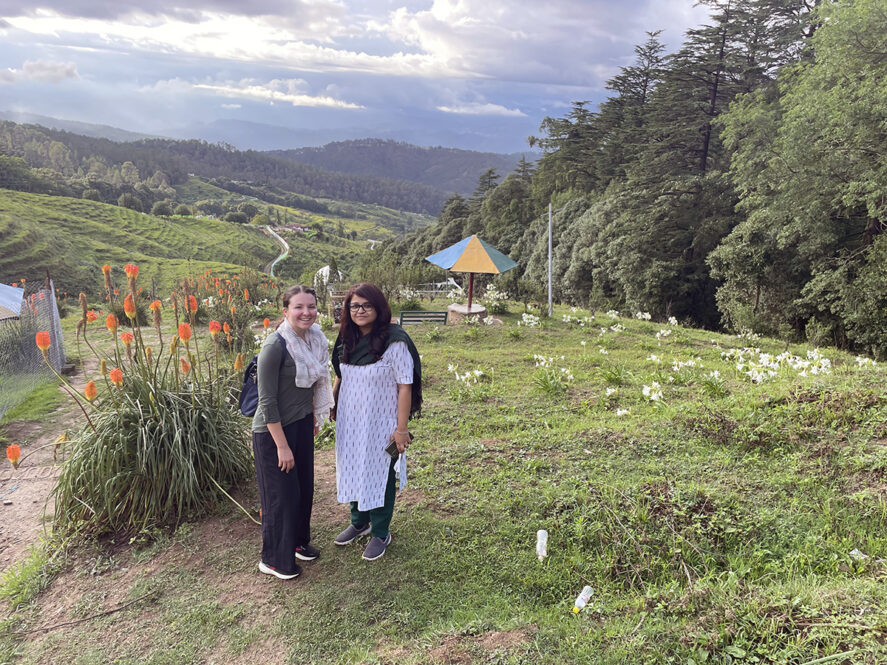Rural America to Rural India: Perspectives Gained

Growing up on a small farm in Upstate New York, I always knew agriculture as a labor of love, one of recognizing cows by their personality and determining the season based on what was being harvested. As I grew up and got to know other farms, I realized that the majority of food in the US was produced at a much larger scale than my parent’s hobby farm. This included dairy farms, like my uncle’s operation, milking 800 head or more, and grains grown on thousands of acres out west. I got to know the culture around agriculture production in the US, one of deep community and hard work. This was built as I worked in agriculture policy in Washington, DC, and experienced a few positions on commercial farms throughout high school and college. All these experiences helped build my understanding of the agriculture sector in the US. This was an understanding that I could draw upon when comparing food systems across the world and learning all about the vastly different Indian agriculture sector.
This past summer, I was an intern with the Tata-Cornell Institute for Agriculture and Nutrition (TCI), focused on studying how farmer producer organizations (FPOs) can help women support themselves and their families. I was able to visit many places, including the Himalayan town of Ranikhet and the state of Bihar.
One of my first realizations after starting to research agriculture in India and observing Indian farms was how deeply woven agriculture was in the lives of many Indian people. In the US agriculture industry, we often discuss the disconnect between producers and consumers, with many consumers hugely distanced from the realities for food production and distribution. However, in India, it was instantly clear that much more of the population has a direct link to farming, whether that is a family cow or a small vegetable plot. Statistics demonstrate this concept, as the USDA reports that only 10% of Americans are employed by agriculture and related industries, compared to over 55% of the Indian population making a living in agriculture, according to the World Economic Forum.
Another realization that I had over the course of my time in India was how traditional gender roles still closely affected people’s roles within agriculture. For example, women tended to handle the livestock, as well as doing some of the planting and weeding. In contrast, men usually did everything public facing, such as purchasing seeds and other inputs, operating machinery, and selling to the markets. I saw this in much of the literature I read, as well as directly observing it.
Shifting this dynamic was a central theme in the project I worked on, which was centered around women-only FPOs. These women were independently accessing markets and doing other traditionally male roles; many of them were acting as the head of their households for various reasons. These practices represented the ideals of hard work and courage, in addition to creating income for many of the members.
I was able to visit with many members of Umang, a 15-year-old FPO in the Himalayas that produces knit goods, jams, chutneys, grains, and many other handmade or cultivated goods.
Talking with these women caused me to reflect on gender dynamics in American agriculture. Although women in the US may be considered more equal to their male counterparts than in India, they still deal with defying the “norms,” such as men usually working with tractors and other machinery. In this sense, I could begin to understand how much of a challenge it must be for the Himalayan women I spoke with to go outside of traditional roles to create better livelihoods for their families. One woman reported that some women had to hide their knitting from the rest of their families in the beginning of belonging to the organization, due to the stigma around women making their own income. It was clear that this community of women had come very far in introducing their families to new ideas about women having more independence and demonstrating their true capabilities.
Recapping these conversations with TCI researcher Dr. Pallavi Rajkhowa in the evenings in the Himalayas, I started to truly see how universal agriculture was. We discussed the stories the women had shared with us, our own roots in agriculture and our perspectives on everything from marketing strategies to dietary choices. It was invigorating to be in the constant presence of so many people passionate about rural agriculture development and the human rights to autonomy, food, water and other needs.
After this internship, it’s clear to me that agriculture across the world has a common thread of being community-based and full of hard-working, passionate people. Despite the wide variety of crops and cultivation scales between the US and India, a love of the land and passion for feeding communities was evident across cultures. This experience has truly been once in a lifetime and has given me perspective I will carry into the future.
Grace Catherine Dunham was a TCI intern with the CALS Global Fellows Program in the summer of 2024. She is a global and public health sciences major in the College of Agriculture and Life Sciences at Cornell University.
Featured image: Grace Catherine Dunham with TCI Associate Research Fellow Pallavi Rajkhowa. (Photo provided)

